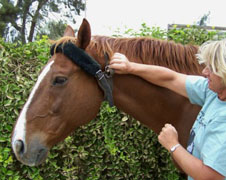 Cribbing is at the top of the list of stable vices, probably because it’s destructive and difficult to cure. A horse that cribs uses its upper incisors to grab hold of a solid object and then arches its neck until the muscles of its throat bulges. Often the horse will make a grunting sound as it gulps in a small amount of air. The habitual cribber leaves broken boards and weakened corral panels in his wake. The horse suffers, too. Most cribbers are poor keepers. Since they’re pre-occupied with cribbing, they don’t graze or eat as much as they should. Ingesting too much air predisposes them to gas colic. Plus, their upper incisors become unnaturally worn. So, what can you do if you’re saddled with a cribber?
Cribbing is at the top of the list of stable vices, probably because it’s destructive and difficult to cure. A horse that cribs uses its upper incisors to grab hold of a solid object and then arches its neck until the muscles of its throat bulges. Often the horse will make a grunting sound as it gulps in a small amount of air. The habitual cribber leaves broken boards and weakened corral panels in his wake. The horse suffers, too. Most cribbers are poor keepers. Since they’re pre-occupied with cribbing, they don’t graze or eat as much as they should. Ingesting too much air predisposes them to gas colic. Plus, their upper incisors become unnaturally worn. So, what can you do if you’re saddled with a cribber?
If you have a confirmed cribber there are two types of deterrents. The most common option is a leather cribbing collar that prevents the neck muscles from expanding. It doesn’t halt the habit of cribbing, it merely reduces the effect. When adjusting a cribbing collar, find a happy medium between getting the collar tight enough to do its job and yet loose enough so that the horse can still eat, drink and breathe without discomfort. The standard rule is that a cribbing collar should be buckled tightly enough to remain in place without shifting when the horse lowers its head, but loose enough so that you can slip two fingers underneath the collar and the horse’s throat. A more permanent yet costly alternative is laser surgery. Performed under general anesthesia, the Modified Forssell’s Procedure clips the precise nerve and muscles utilized in cribbing. Though there is some recovery time and minimal scarring involved, the surgery has proven to be quite successful in permanently ending or greatly reducing the ability to crib.
Finally, when attempting to curb cribbing, don’t resort to inhumane treatments. Collars that zap a horse with electricity or prick him with sharp metal spikes haven’t proven to be any more successful than plain leather collars. Another anti-cribbing tactic is to insert metal hog rings between the horse’s upper incisors, with the idea that the rings will prevent the horse from grabbing hold of an object with his teeth. Hog rings are placed in a pig’s snout to prevent them from grubbing through the dirt and under fence lines; they are not meant to be crammed between a horse’s teeth. In fact, the American Association of Equine Practitioners (AAEP) has released a statement against the use of hog rings in horses, citing “visible damage to the gingiva (gum tissue)” and “the potential for persistent pain.” Dealing with a cribber can be frustrating, but it should always be approached with an educated mindset and a concern for the horse’s welfare.

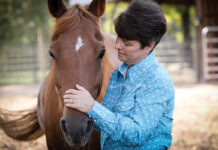
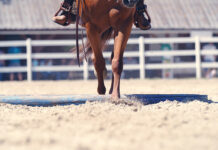
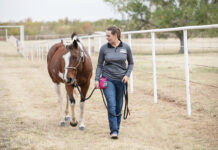
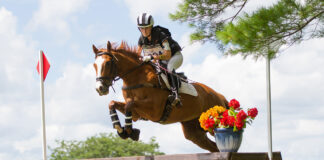

Good advice – thanks!
I’ve had a cribbing horse and it’s well nigh impossible to stop. And the leather collar would make sores on her delicate neck so I had to remove it. I think the only way to stop it is to make sure that there are no surfaces on which they can crib. And it’s a very bad addiction which can never be fully cured.
I think the article forgot to mention the you should put buckets and feed pans at ground level. horses typically wont crib that low. Also, checking for ulcers is another option. My horse started cribbing one day for no apparent reason. After alot of reseach we had him check for ulcers and the put on preventitive. I haven’t seen him doing is since, and he doesnt were a collar
I agree with everyone here,and although most horses will completely stop cribbing when given 24/7 turnout, I have actually seen horses go to a post and crib there all day long,instead of grazing. That’s how addicted some horses get. Thanks for the advice though! It was awesome! And yes I agree with Amber. Buckets and Feed pans at ground level is a great idea.
One of the mares at my friends ranch cribs, but she doesn’t grab onto anything. One of the geldings will use his water buckets, even if you give him hay.
I recently acquired a cribber. He has ulcers, a super busy brain, and is stabled (not turnout yet in Oregon, still too wet! but that will be coming soon)
I bought a “busyhorse.com” hay bag, it slows down his feeding and keeps him busy for much of the day, thus slowing down the cribbing. I and others have noticed however that the more “stress” in the barn the more he cribs, thus he cribs more when I am about to leave and cribs more when the roudy kids are in the barn. The collars dont work and neither does nasty tasting stuff. The busyhorse works the best as well as keeping a calm atmosphere and dealing with a cranky stomach.